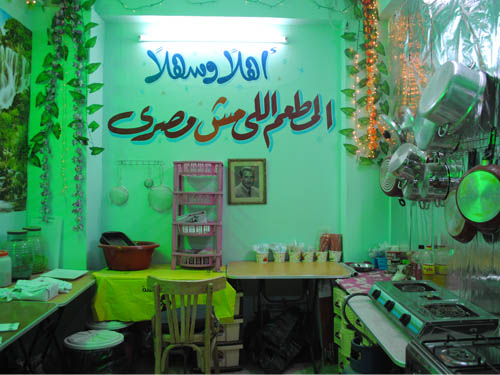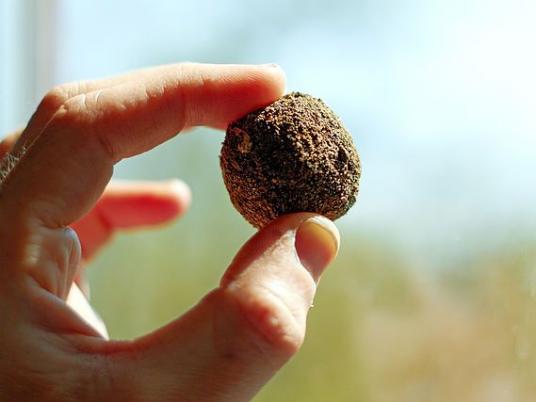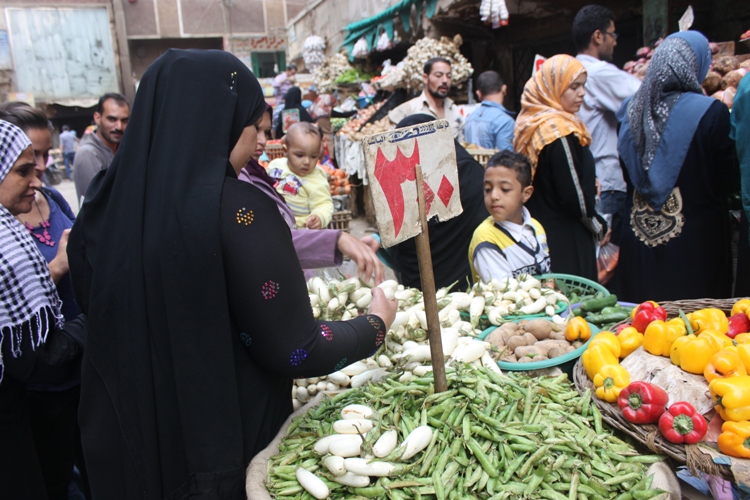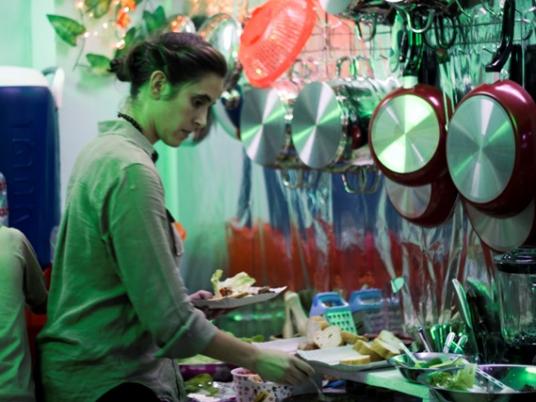
For most of us living in Cairo, it’s often difficult to imagine what our neighborhoods might have looked like in the past. Until the mid-19th century, downtown Cairo was covered with swamps; a few decades down the line, what is now Heliopolis was still desert land; and the busy, bustling streets of Mohandiseen, and its adjacent labyrinthine Ard al-Lewa were until the 1960s agricultural fields. Wandering through these neighborhoods, their past seems unrecognizable and at times difficult to believe. But, if you dig down under the surface the way artist Asuncion Molinos Gordo and Egyptologist Salima Ikram did in late November, one can still find traces of the past. Only half a meter deep in a ramshackle parking lot on one of Ard al-Lewa’s side streets, the excavators found moist fertile soil.
The search for these “traces of a dying peasant civilization,” as Molinos describes it, was the last phase in the artist’s pop-up restaurant “El Mataam El Mish-Masry.”
Throughout November, Gordo set up an art project in the guise of a restaurant at the shopfront of the Ard al-Lewa art space. For her, “El Mataam El Mish-Masry” (which translates as The Non-Egyptian Restaurant) was both a research and conversation platform. She has been interested in issues of food sovereignty (the ability of the people of a nation to decide what to grow and eat) for years now. So she carefully designed her restaurant; the walls a familiar pale green with artificial flowers lining the inside of the kitchen, and the wall above the stove covered in aluminum foil to make cleaning easier. On the front wall, behind a metal street cart for food display, she hung a black and white photograph of her grandfather (a Spanish farmer) in the fashion of Egyptian restaurants. Small metal tables and wooden chairs lined the sidewalk of the restaurant. It is there that visitors could enjoy meals throughout the four weeks.
Ard al-Lewa is now more famous for its artisans than its farmers; with the exception of a deeply polluted water canal that runs in parallel to the houses, little signs of agricultural life are apparent as urban sprawl has taken its toll on the area. The older neighborhood residents remember what it was like before; the young ones have only experienced Ard al-Lewa as a very busy and highly populated area, the buildings so high compared to the narrow streets that pedestrians are rarely exposed to direct sunlight.
The restaurant offered a space to discuss some of these issues more openly. In the first two weeks, an international chef served meals cooked from foodstuffs grown in Egypt for export markets, while women from the local Women and Society Association cooked based on their household budgets. The stark contrast initiated numerous conversations with the restaurant’s “clients.” The menus were designed with a clear message to contrast the two categories, but eventually developed at the request of the local cooks who wanted to serve what they do on feasts and have a more celebratory and communal feel to the dinners in the second week. And indeed, when they changed their menu from lentil soup to stuffed vine leaves, a bigger crowd turned up, taking the conversations to a new level.
Some challenges arose along the way, as by the end of the second week when neighborhood residents were just getting to know the place and stop by every night for a meal and chat, the dishes turned inedible. In the third week, Gordo prepared meals from what she could find scanning a one-kilometer radius of land around the restaurant. She made mahshi from cigarette butts and candy wrappers and put them on display in the glass vitrine. Intuitively, it was more children than grown-ups who gathered for the discussions. But that was no failure for the restaurant, as those youngsters are the future of Egypt, explains Gordo, and they were the ones who knew the least about the history of their neighborhood. The most remarkable reactions came when she displayed the fertile soil she had dug up with Ikram in the final week, highlighting what was found at each depth. The children would touch it and wonder how much their environment has changed.
“There’s little we could do about it,” said one nine-year-old to whom a young teenager responded, “No, we can express our concerns at Tahrir Square.” Those days coincided with ongoing protests at Tahrir Square when clashes broke out again between protesters and security forces on the one-year commemoration of the Mohamed Mahmoud clashes, and continued with President Mohamed Morsy issuing the 22 November Constitutional Declaration which was partially replaced on 8 December.
For the closing night, Gordo wanted to serve oven baked chicken, duck and stuffed pigeons, home grown by the residents on their rooftops for their own consumption. But, that was easier said than done. The excavation she undertook with Ikram a few days before was surprisingly easier than finding the birds — the main challenge for the former being finding a location that was not built upon or paved for cars and tuk tuks to dig up. Those working at the parking lot did not mind Gordo and Ikram’s small intervention. In fact, they gathered to watch and started engaging with the project, welcoming whoever dropped by later with the artist to see the excavated site.
The search for the poultry — another remnant of farming culture — was more difficult. At noon, participants in the project started searching for home grown poultry — the healthiest and accordingly more expensive than what is available at the market. As they asked around if residents grew poultry on their rooftops, everyone replied with a definitive “no.” But as they got up on the rooftop of the Ard al-Lewa art space, they could see that neighboring rooftops hosted cattle and poultry. The conclusion Gordo drew from this experience was that the residents “valued their animals so dearly and were not willing to sell them.” Those were only for house consumption, said one vendor at the local market — “You will not be able to buy any.”
So on the closing night, Gordo served an empty plate. But to her, that was part of the research she does. She never meant to come and educate the local community about their neighborhood and changing conditions. All she sought was to highlight some aspects of national agricultural policies more clearly — which culminated in a public meeting and discussion about what the residents wanted to do next in early December
“El Matam El Mish-Masry” at times seems overtly political. But this is not something that Gordo is trying to negate. From its onset, the aim of the project was political, and the whole design was reached with that aim in mind: reaching those generally unengaged with art. It does not aim to preach, as Gordo listens as much as she talks. And its success is perhaps most apparent in that by the end of the project, pedestrians, shop keepers and workshop owners all greeted Gordo as she walked by asking how they could help with the project and showing much enthusiasm. Some want to open their own restaurant. Others have the discussions in the back of their minds and are debating what their next steps might be.





